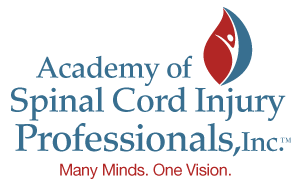Letter of Support for the Connect for Health Act of 2023

Dear XXXXXXXXX
The Academy of Spinal Cord Injury Professionals strongly urges you to co-sponsor S2016/HR4189, the Connect for Health Act. ASCIP is a not-for-profit incorporated association whose mission is to optimize the health and wellness of individuals with spinal cord injury or disorder (SCI/D) through advanced interdisciplinary education, professional development and scientific research. Telehealth offers a lifeline for individuals with SCI, improving access to quality care, managing chronic conditions, and reducing unnecessary hospitalizations.
Imagine Randy with a spinal cord injury, living hundreds of miles from his specialist and lives in Alaska. He must take two planes and a boat to travel for appointments so medical appointments are a logistical and financial nightmare. The Connect for Health Act can help Randy and millions of Americans with disabilities achieve individualized optimal mental, social, and physical health.
The Challenges of Traditional Healthcare for Individuals with SCI
For individuals like Randy, accessing essential healthcare services can be incredibly difficult. These challenges include:
- Limited Availability of Specialized Care: Many areas lack specialized SCI clinicians, forcing patients to travel long distances for appointments.
- Geographic Limitations: Rural residents face additional challenges due to the distance from specialists and lack of accessible public transportation.
- Transportation Barriers: Transportation costs, both financial and time-related, create a significant hurdle for individuals with mobility limitations.
- Physical Obstacles: Many primary care offices are not fully accessible, with issues like parking, ramps, doorways, and exam tables making in-person visits cumbersome and inefficient.
- Lack of SCI Knowledge in Primary Care: Many primary care physicians lack the specialized knowledge required to effectively manage SCI on their own, necessitating specialist involvement.
These factors, combined with the high cost of non-emergency medical transportation, often lead to:
- Reduced Patient Follow-Through: The difficulty and inconvenience of traditional care result in a significant number of patients missing appointments, especially those in rural areas or of minority status.
- Increased Hospitalizations: Delays in care due to missed appointments can lead to costly hospitalizations and potentially irreversible complications.
- Increased Use of Emergency Rooms: Difficulty accessing primary care can lead to a reliance on emergency rooms for non-emergent needs, driving up healthcare costs.
The Financial Burden on Taxpayers
It's important to note that over 50% of individuals with SCI rely on Medicare or Medicaid. The challenges outlined above contribute to a significant financial burden on the healthcare system, ultimately impacting taxpayers.
Telehealth as a Solution
Telehealth offers a powerful solution to these challenges. Studies show that telehealth for SCI patients leads to:
- Increased patient satisfaction and adherence to treatment plans.
- Reduced healthcare costs by minimizing travel and emergency room visits.
- Improved quality of life by empowering patients to manage their health from home.
The Connect for Health Act's provisions, such as permanently removing geographic restrictions, will unlock these benefits for countless Americans. This legislation aligns perfectly with your commitment to innovation and expanding access to quality healthcare, especially in rural areas.
We urge you to co-sponsor the Connect for Health Act and advocate for its swift passage. Let's work together to ensure Randy, and millions like him, receive the care they deserve.
Sincerely,
________________
References
- McColl MA, Aiken A, Smith K, et al. Actionable Nuggets: Knowledge translation tool for the needs of patients with spinal cord injury. Canadian Family Physician. 2015;61(5):e240-e248.
- Ecolane. Non-Emergency Medical Transportation (NEMT) Rates. Published February 24, 2024. Accessed February 24, 2024. https://www.ecolane.com/blog/non-emergency-medical-transportation-rates
- Sechrist S, Lavoie S, Khong CM, Dirlikov B, Shem K. Telemedicine using an iPad in the spinal cord injury population: a utility and patient satisfaction study. Spinal Cord Ser Cases. 2018;4:71. doi:10.1038/s41394-018-0105-4
- Khong CMM, Pasipanodya EC, Do J, et al. SCiPad: evaluating telemedicine via iPad facetime for general spinal cord injury care. Spinal Cord. 2022;60(5):451-456. doi:10.1038/s41393-022-00790-1
- Kim H, Cutter GR, George B, Chen Y. Understanding and Preventing Loss to Follow-up: Experiences From the Spinal Cord Injury Model Systems. Top Spinal Cord Inj Rehabil. 2018;24(2):97-109. doi:10.1310/sci2402-97
- Parast L, Mathews M, Martino S, Lehrman WG, Stark D, Elliott MN. Racial/Ethnic Differences in Emergency Department Utilization and Experience. J Gen Intern Med. 2022;37(1):49-56. doi:10.1007/s11606-021-06738-0
- Guilcher SJT, Craven BC, Calzavara A, McColl MA, Jaglal SB. Is the emergency department an appropriate substitute for primary care for persons with traumatic spinal cord injury? Spinal Cord. 2013;51(3):202-208. doi:10.1038/sc.2012.123

